Managing Rain and Run-Off with the Right Plantings
The Elements of Life
Water, light, and air fuel our lives. We depend on them, as does every plant and animal. Light energy powers the chemistry of photosynthesis to transform elements like carbon and hydrogen into sugars, food. Oxygen fuels the production of life energy in every living cell. And water fills every cell of every living creature; gives us sap and blood; powers every process of life. There is no life, not even the tiniest microbe, without water.
Yet our relationship with water has grown complicated. The steady pounding of rain, flowing of creeks and rivers, the rising tides, waves crashing on the shore, have grown undependable. Flood and drought, storms and wildfires inhabit our worries and our headlines. We have both too little and too much.
Like the Hindu gods Brahma, Vishnu and Shiva, water creates, sustains, and destroys our world. It moves in a constant dance of transformation, but the rhythms have grown undependable, perhaps too unpredictable. Both too much and too little water destroys the life it would normally sustain. The delicate balance that sustains with comfortable predictability is unraveling.
Elements of Transformation
Carbon and oxygen, hydrogen and nitrogen, the indispensable elements of all life, fuse into carbon dioxide, CO2, with every burning, every exhalation. They rise from uncovered earth and decaying life as unseen gas drifting into the atmosphere. The elements of life fuse into nitrogen dioxide, NO2, sulfur dioxide, SO2, and methane, CH4. These gasses hold the sun’s energy close to the Earth, making it harder for heat to dissipate into space. They warm the oceans, melt snow and ice cover, and dry out the land. They are born from destruction: burning, digestion, and decay. They are born from transformation: manufacturing, volcanic activity, and the breath of every living animal.
Warmer air speeds evaporation from land, ice, and sea and holds exponentially more water vapor than cooler air. As the Earth’s temperature heats a bit more each year, the air becomes more humid. Snow and ice packs disappear. Dew points rise. Thirsty areas go for weeks without rain. And when the rains finally come, it rains harder and longer than ever before. We see rivers drop to historic levels in some places while flooding rains change the course of rivers by eroding new channels in others.
Searching for Systemic Solutions
Solutions are scarce. The problem is bigger than any one person or group or nation can fix. Even the air conditioners so critical for humans to survive high heat and humidity add to the greenhouse gasses warming the air. Temperatures plummet in some areas as they rise in others, requiring more combustion for heating. Weather records break even as we continue generating those gasses that hold excess heat and humidity in our atmosphere.
But we want to do something. We want to be a part of a solution, and we also want to insulate our own homes and lives from some of the worst damages caused by chaotic weather. How do we begin to heal the Earth? How can we help scrub the air clean of greenhouse gasses, manage excessive rainfall, shade and cool our home, and also channel water strategically around our own yard? How do we manage our landscape through drought? Choosing the right plants, and planting them strategically, is an action each of us can take to create positive changes. We can make our homes safer, more comfortable, and more beautiful with appropriate landscaping.
Selecting Functional Plants
To choose plants for these purposes, we need to consider plant choice strategically, in terms of their functions and tolerances, more than we think of them aesthetically. Most of us want to grow what is pretty, what feels familiar to us. We want to ‘fit it’ to the look of our community. Some of us progress to choosing plants that support wildlife throughout the year. We may settle on host plants or pollinator plants or drupe producing shrubs, or we may seek out mostly native plants.
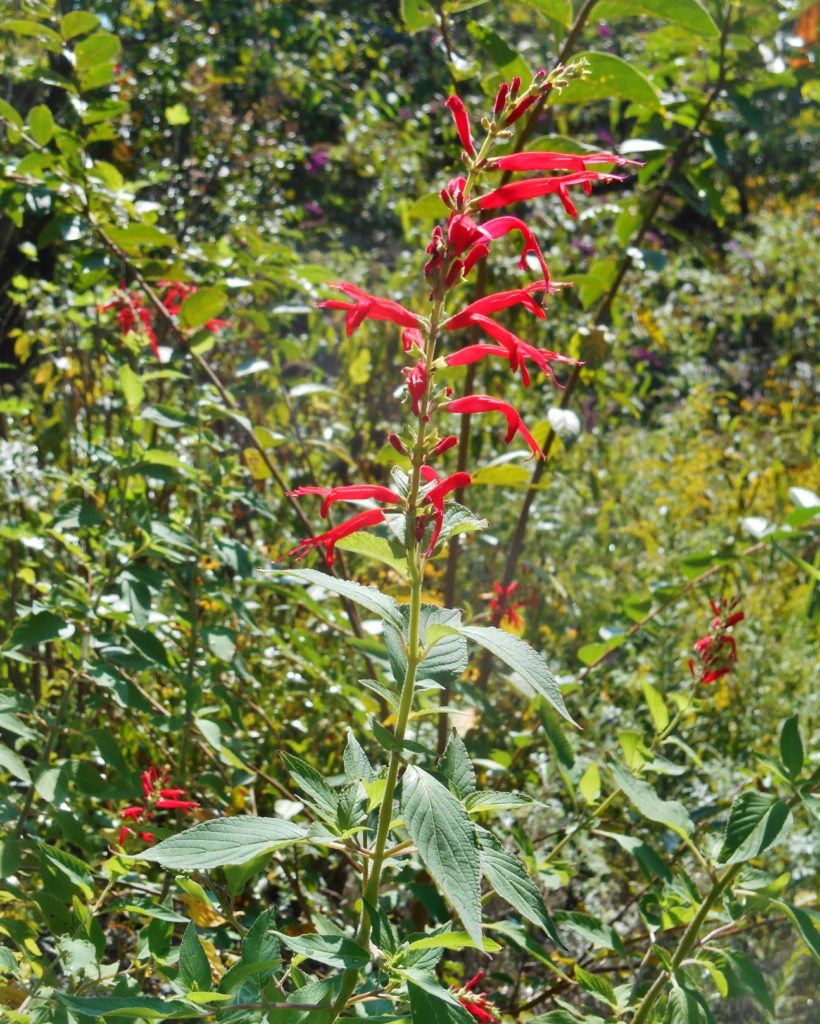
Pineapple sage, Salvia elegans, is a drought tolerant perennial native to Mexico. Late hummingbirds appreciate its flowers, which open in September and October. It has an extensive root system, like the native goldenrod, Solidago, growing in the background.
To plant for weather resiliency, we shift our thinking yet again and expand our awareness to understand how each plant’s structure, above and below ground, impacts its functions in managing rainfall, storm water, erosion, light, air filtration, and carbon sequestration. Evergreen leaves allow a plant to filter air, manage water in the soil, and produce food year-round. Plants with deep and extensive root systems hold the soil against erosion even as they pump more and more carbon, trapped in the cellulose which encases every plant cell, deep into the earth. Deep and extensive roots seek out moisture to sustain the plant through dry periods when there is no rain.
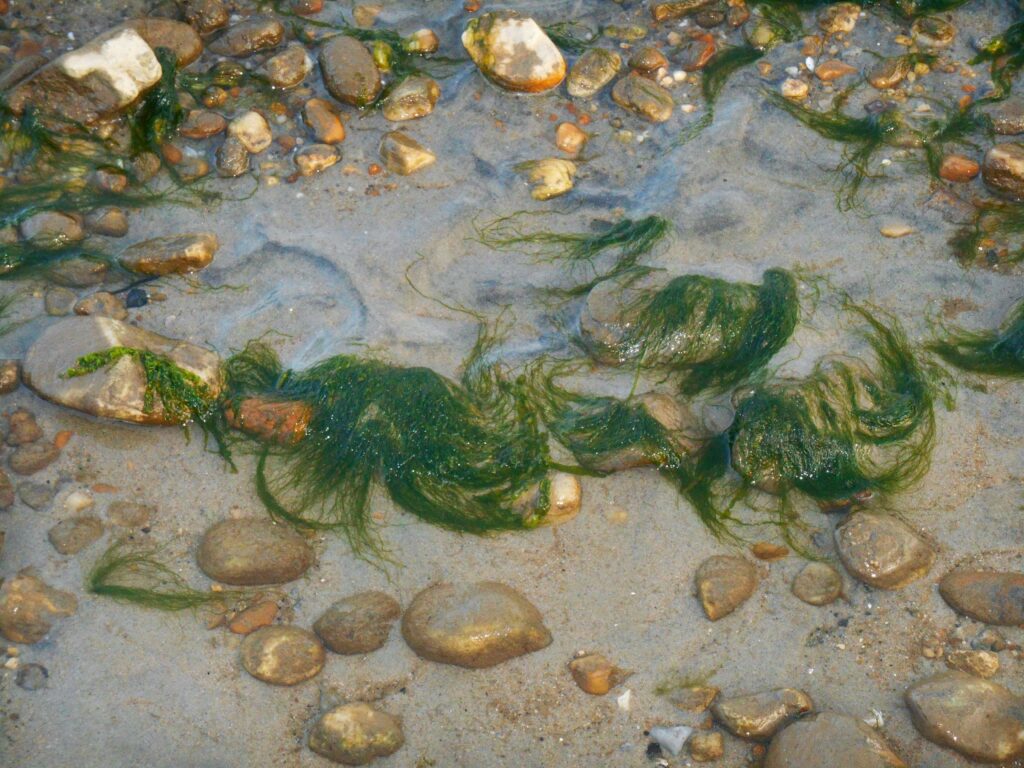
Every plant, even algae, sequesters carbon from the atmosphere in the cells of its body. Algae is particularly efficient at scrubbing carbon dioxide from the atmosphere and there is a great deal of ongoing research into how to use farmed algae for energy production and food production.
Every Plant Sequesters Carbon
Plants photosynthesize carbon captured from the air, and water, in the presence of sunlight, to create cellulose (C6H12O6), a key component of cell walls. A plant’s roots, stems, leaves, flowers and fruit all contain cellulose, along with a variety of sugars and other phytochemicals produced by the plant using elements from air, soil, and water. Each leaf, twig, and root is made grown using carbon captured from the air. Excess oxygen and water vapor return to the atmosphere, exhaled through the tiny stomata found in leaves and bark. When plants grow, they are inhaling greenhouse gasses and sequestering the carbon, nitrogen, and other elements within their plant tissues.
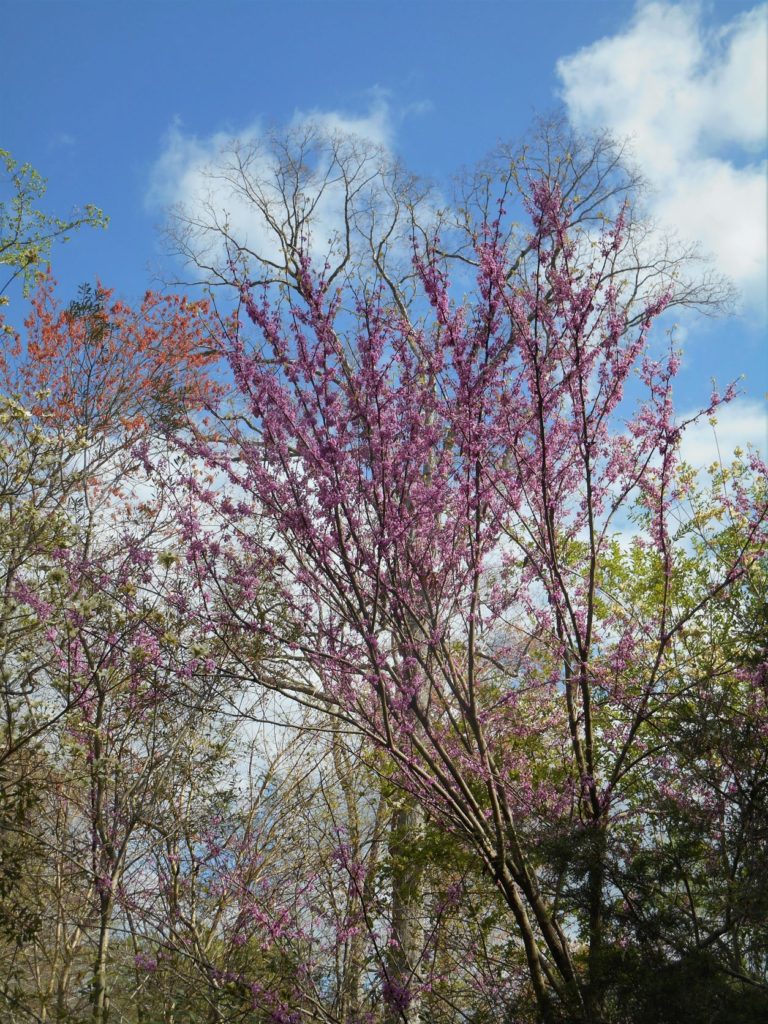
Redbud, Cercis canadensis, is one of many types of trees and herbaceous plants which also scrubs nitrogen from the air and converts it into nodules on its roots, thus naturally adding nitrogen to the soil to aid plant growth.
Biological Nitrogen Fixation
Plants also inhale gaseous nitrogen. Many can convert nitrogen dioxide (NO2) into a nodules of nitrogen that form along their roots, available to fertilize the soil and to share with other plants. Members of 28 different plant families have this ability to scrub nitrogen from the air and transform it to usable fertilizer (NH3) through biological nitrogen fixation, which requires certain bacteria to work symbiotically with the plants’ roots. These include the pea, Fabaceae family, the Betulaceae or birch and alder family, the Myricaceae or wax myrtle family, and the Fagaceae, or beech family.
Common trees like American redbud, black locust, American beech trees, and wax myrtle shrubs fix nitrogen on their roots as they grow. There are many vines, vegetables, flowering annuals and herbaceous perennials in these families, both native and imported, that can all scrub excess nitrogen dioxide from the air and fix nitrogen in the soil. Legumes and cucurbitales, like peas, beans and cucumbers, have this ability.
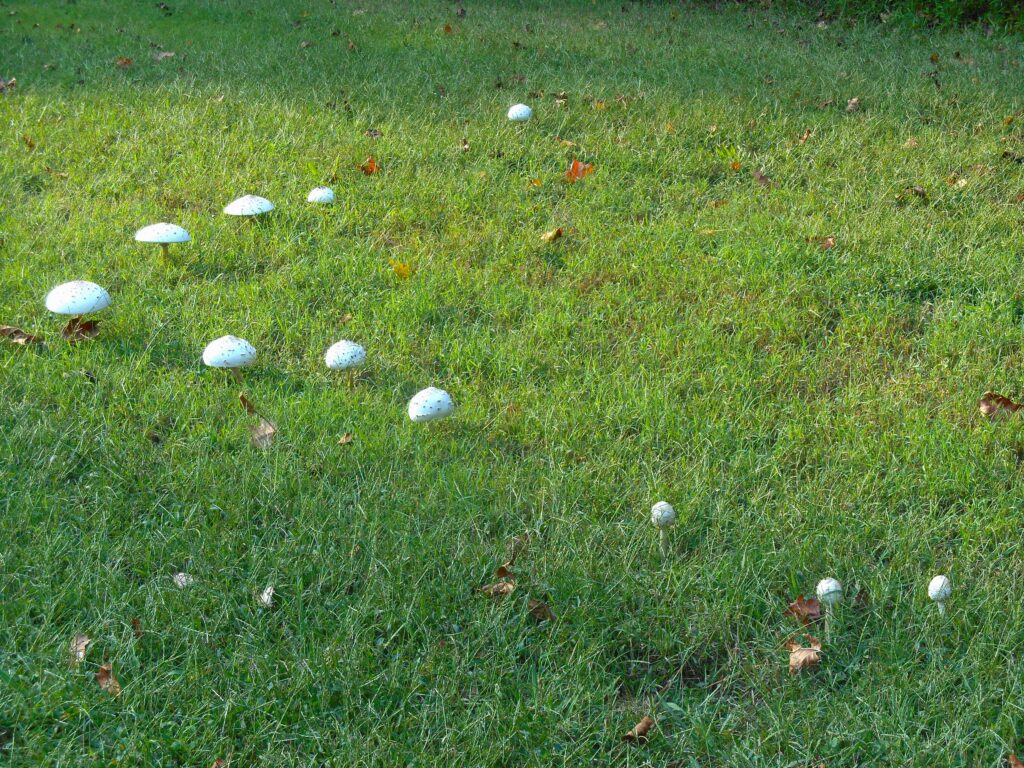
Mushrooms often sprout after a heavy rain in late summer and early fall, evidence of the network of mycelium permeating the soil.
Mycorrhizal Fungi Are Part of the Solution
Plants sequester carbon and nitrogen as they scrub the air, and they cool the air by emitting water vapor and creating shade. Mycorrhizal fungi in the soil, connecting the roots of trees and other plants, also sequester large amounts of carbon, protect soil against erosion, and increase the capacity of soil to absorb and hold onto water until plants need it. Plants, lichens, and fungi helped cool the planet during past geological epochs, without other technology, before humans began using fire and before the industrial age.
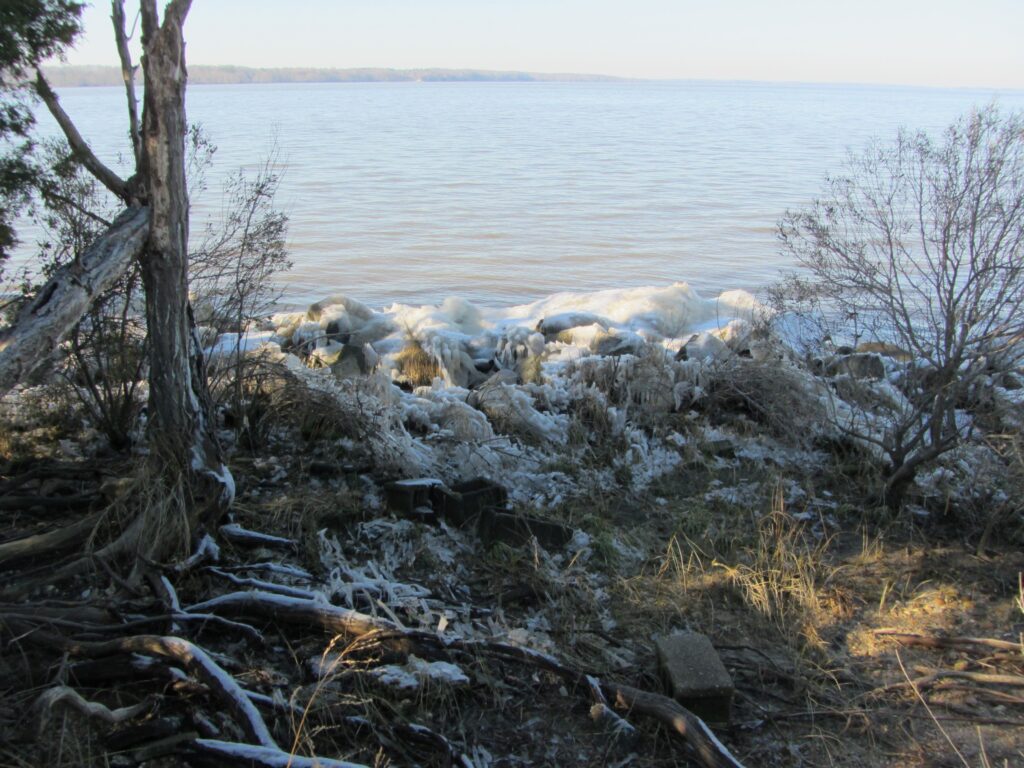
Erosion on the banks of the James River shows how extensive root systems old on to the remaining soil. Water vapor can evaporate directly from ice and snow. December 2022.
Controlling Erosion
Even as roots hold the soil against erosion, so plants themselves protect the soil by breaking the force of raindrops. When rain hits bark, leaves, and stems instead of bare soil, the soil doesn’t erode through the friction of falling and running water. Ground cover plants form a living blanket protecting the soil. But they also cool it, help it hold and process moisture, as they sequester a tremendous amount of carbon.
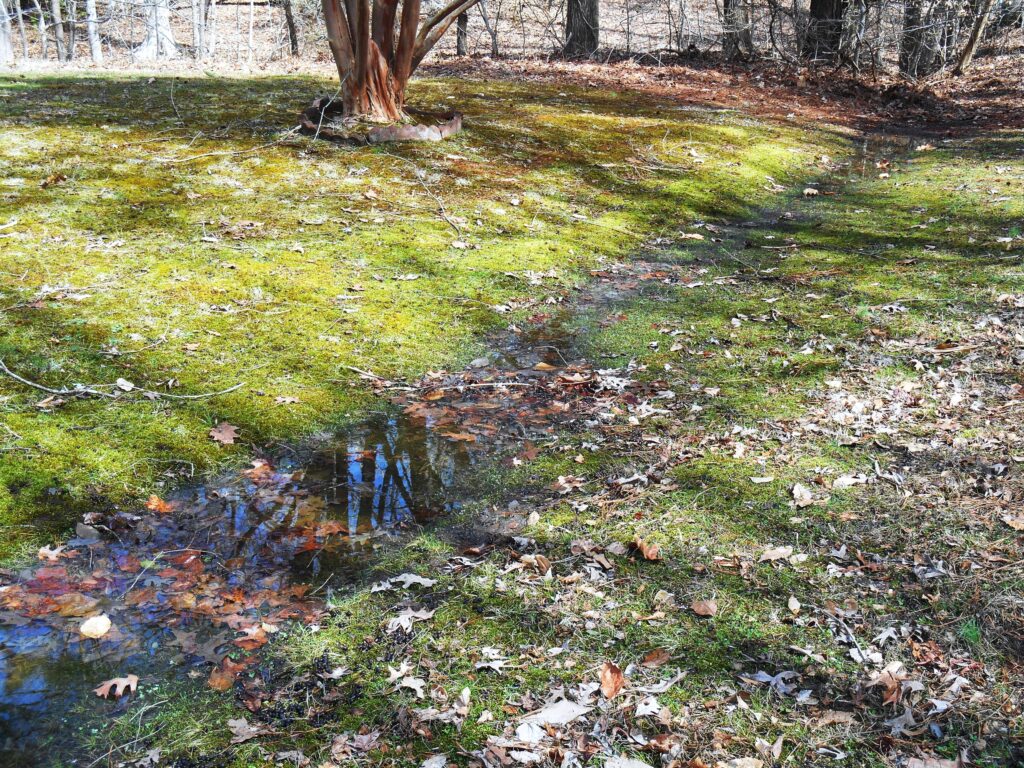
Moss is the simplest and most cost effective ground cover in damp, shady areas. It grows best on compacted soil and protects to soil against erosion even as it prevents carbon dioxide from returning to the atmosphere from the soil.
Turf grass is our usual choice to cover most of our yard with vegetation. It usually does a pretty good job of absorbing rain and limiting erosion. It is green in most seasons, familiar, and grows easily from seed. But most turf grasses require full sun to grow well. And they must be mown regularly through the growing season. In most cases, that means a gasoline powered mower emitting exhaust every time we cut the grass. Turf grass needs regular water, fertilizer, and may need treatment with pesticides. It requires our time and resources to maintain at a steep environmental cost. Turf grass doesn’t support many wildlife species, doesn’t sequester very much carbon, requires us to fertilize it with manufactured nitrogen, and doesn’t grow well in complex, layered landscapes.
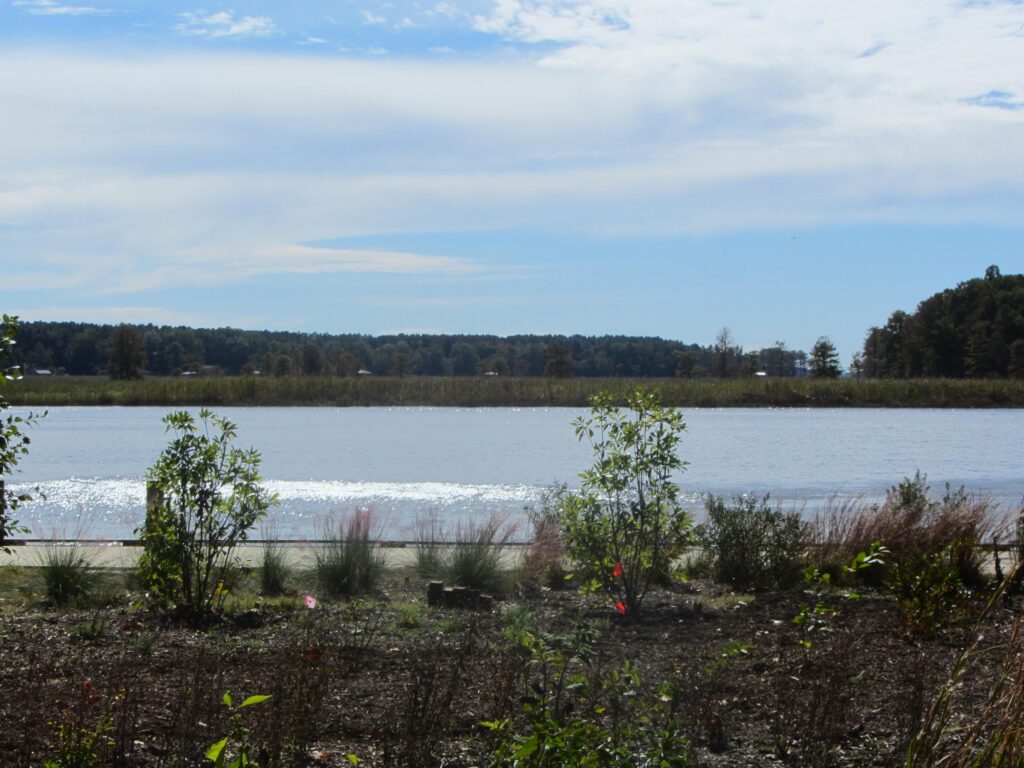
Newly planted beds in the riparian buffer along the Chickahominy River at Brickyard Landing Park include a variety of native trees, shrubs, grasses, and perennials. This planting will develop into a richly layered garden that slows and filters storm water run-off while also attracting and supporting many types and species of wildlife, including birds and pollinators.
Benefits of a Layered Landscape
Planting a garden in many layers increases the volume of plants growing on a given spot. The taller plants create shade. The many layers of living leaves each filter pollutants and greenhouse gasses from the air, making the area a healthier and more comfortable place to live. There is literally more oxygen available to breathe. There is more life.
When planning a layered garden, we have a few larger trees with deep roots and a spreading canopy of leaves. How many, and how closely planted, depends on how much shade we want to create and the size of our yard. Even a single large tree provides important benefits. Smaller trees that grow to 20’-30’, and also shrubs, fill in between the larger trees. Evergreen broadleaf shrubs and conifers provide benefits year-round.
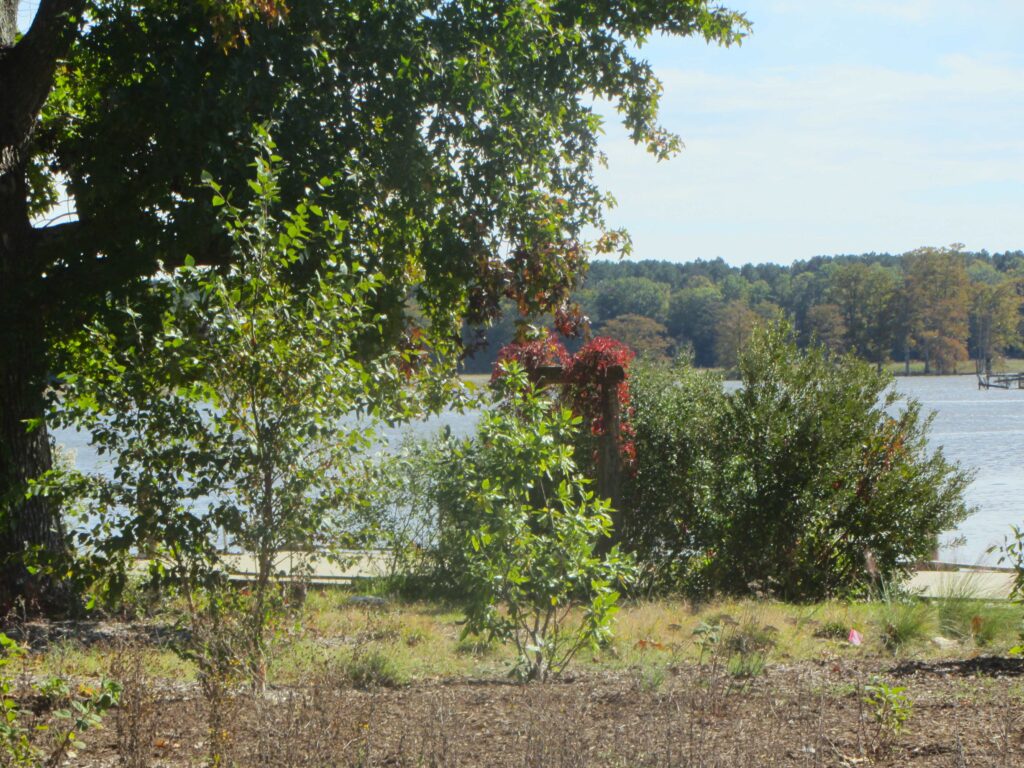
Mature trees and shrubs anchor this newly planted riparian buffer along the Chickahominy River. This area is still under construction, a work in progress. The grasses and perennials transplanted this summer will fill these beds next summer. Trees planted this fall will take a while longer to mature into their potential. Brickyard Landing Park, October 2024.
The next layer includes herbs, sedges, ferns, annual or perennial flowering plants, and smaller ground cover style shrubs. The spaces in-between larger plants and drifts accommodate low growing perennials as ground cover plants. Even mosses, which grow easily in shady damp areas on compacted soil, serve as functional, living ground cover. Many gardeners use mulch on paths and as ground cover between plants. And mulch is a good choice in many situations. Fallen leaves and branches are nature’s mulch under trees. But mulch decays, releasing carbon into the air and must be renewed at least annually. And mulch doesn’t carry on photosynthesis, cleaning the air.
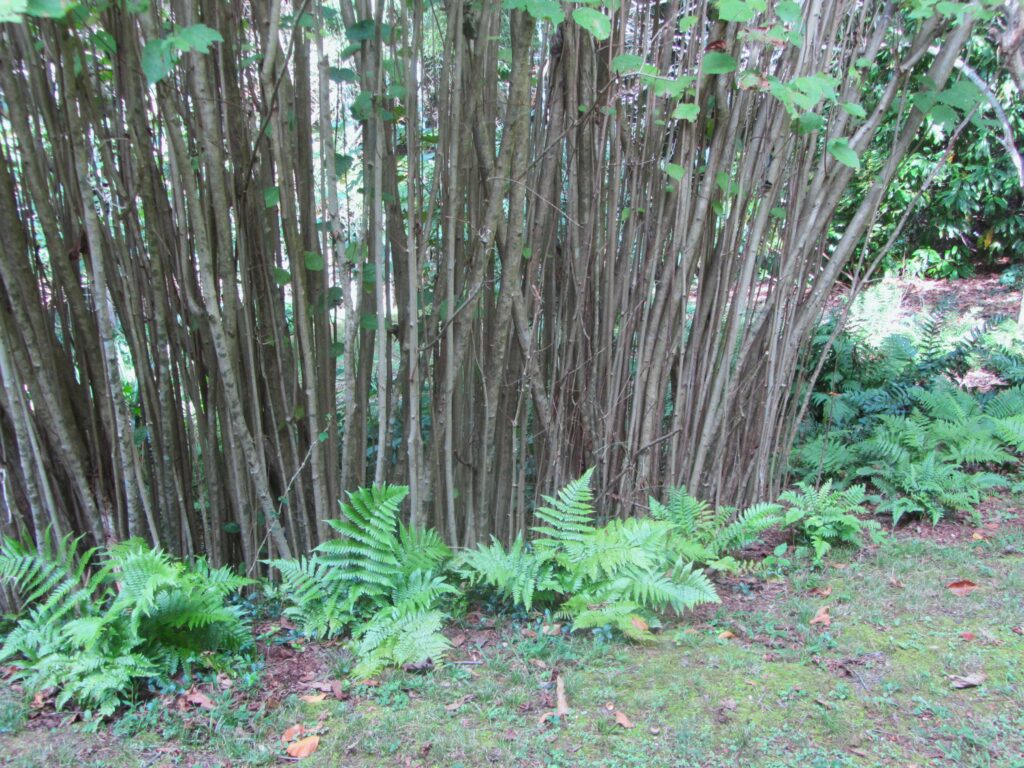
A stand of spreading American hazelnut grows along the edge of a slope, slowing run-off and erosion. Newly planted ferns on the uphill side will further slow erosion and make the bank more stable over time. These ferns will expand into a solid ground cover layer within another year or two.
Functional Design
Planning how to arrange the plants depends largely on the size and shape of the available land, whether it is flat or sloping, and how water needs to drain across the land to avoid flooding structures like our home and garage. But in general, large, planted areas situated across the flow of water, to stop and interrupt it as it travels downhill, both slow it down and reduce erosion. Encouraging the water to soak into the deeper levels of soil instead of running off to somewhere else has many benefits for our own plantings, as well as for nearby waterways. Large planting beds, with water permeable paths between them, manage rain efficiently.
Suckering and spreading trees and shrubs, planted perpendicular to the flow of stormwater run-off, serve a similar purpose. Their extensive roots and suckers interrupt the flow and absorb excess water. American hazel, pawpaw, and sassafras trees perform this function well and tolerate a wide range of growing conditions. Grow ground cover plants at their base, on the uphill side of the planting, to prevent erosion around their roots.
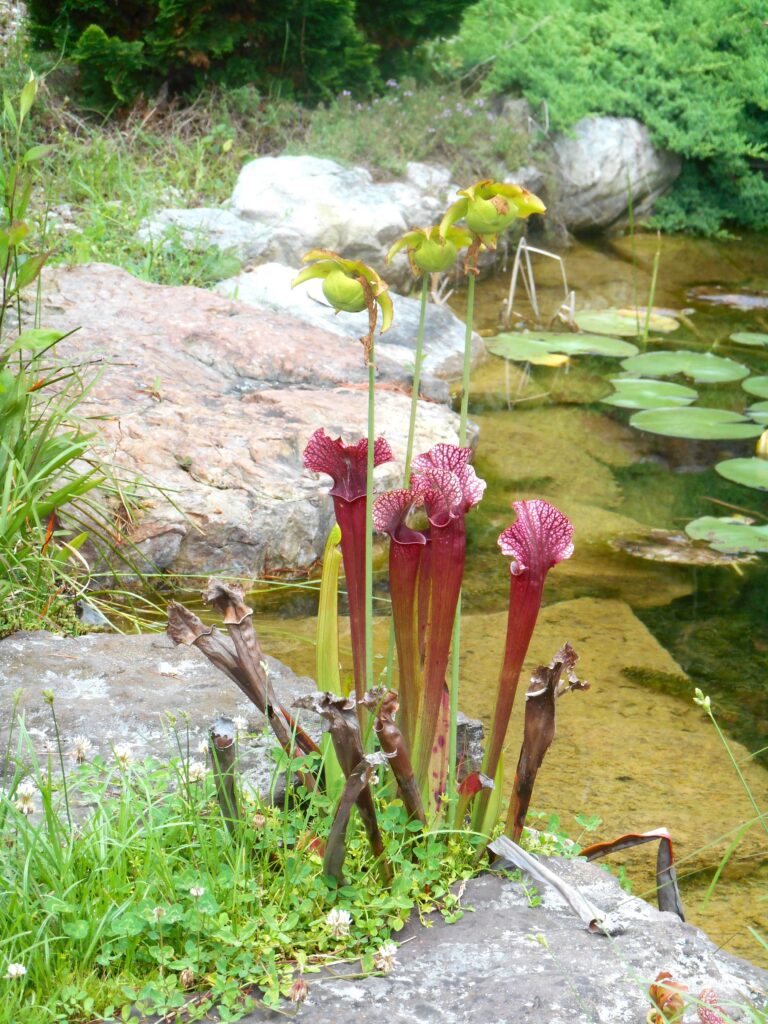
Native Sarracenia grows in the gardens at Brent and Becky’s Bulb Shop in Gloucester, Virginia. Clover, growing between the stones, fixes nitrogen into the soil to feed neighboring plants.
Rain gardens take this idea a step further by capturing rainwater in a temporary holding area, like a small, temporary pond. Appropriate plants, that can grow in saturated soils, can be planted in and around the rain garden. It is important to have an ‘exit strategy’ for excess water to drain off to another area during exceptionally heavy rains.
While shrub hedges and wide planting beds around a home form the traditional foundation planting, homeowners in some parts of the country are rethinking this design to make their homes more resilient to wildfires. Many shrubs are highly flammable. Wood based mulches can be flammable. Periods of drought make us more aware of how easily fires can start and spread where the vegetation has dried out. Gravel mulch, containerized plants, and succulents or drought tolerant shrubs can make our foundation plantings more fire resistant. Large, drought tolerant ferns and ground cover vines work well in shady areas near the foundation of a building.
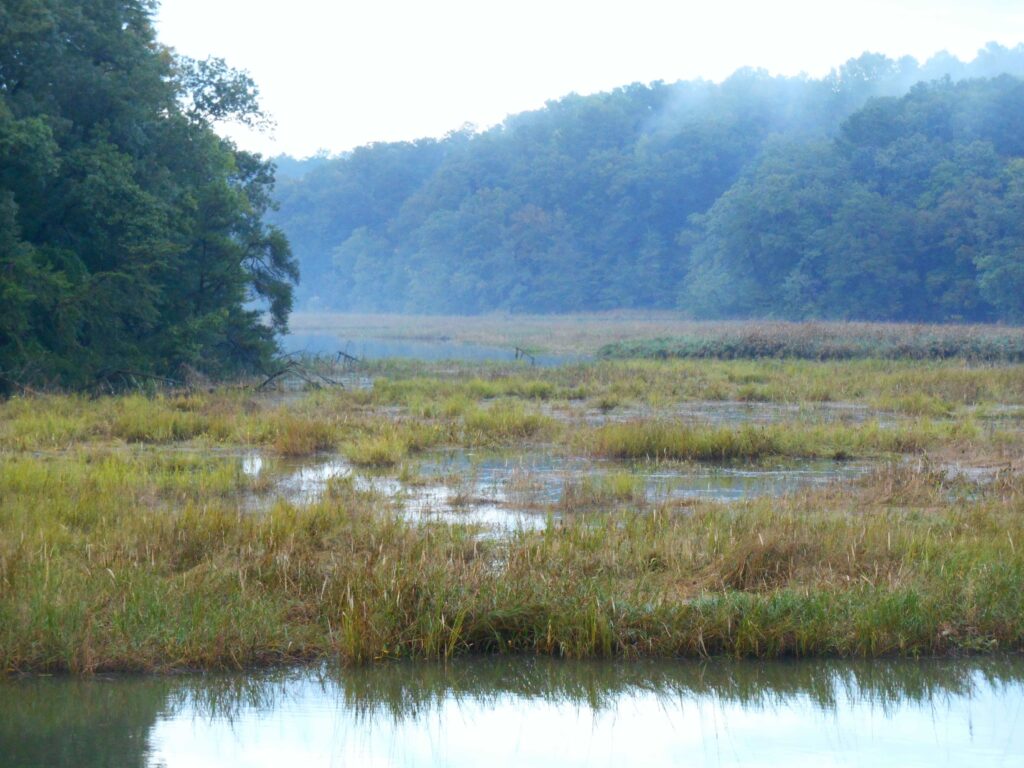
Mist rises over Halfway Creek, James City County VA, on a cool September morning. Water vapor rises from trees through transpiration, forming clouds that will eventually bring more rain to the area.
Change of State
Plants help manage storm water run-off because their roots absorb the excess water from the soil. They use the water for their own growth, and harmlessly release excess water vapor back into the atmosphere. Plants literally pump gallons of water from the soil each day before releasing water vapor back into the surrounding air. Large trees do this very efficiently because of their tremendous canopy. Water vapor gathers to form clouds. Forested areas naturally get more rainfall because they generate clouds. Once an area is cleared for development, this process of returning water vapor to the atmosphere is interrupted. Desertification eventually follows in areas with little rainfall. Several areas of our planet that once were lush with abundant plant growth eventually became deserts. Dry regions can be reclaimed by planting trees and other vegetation that will return water vapor to the atmosphere.
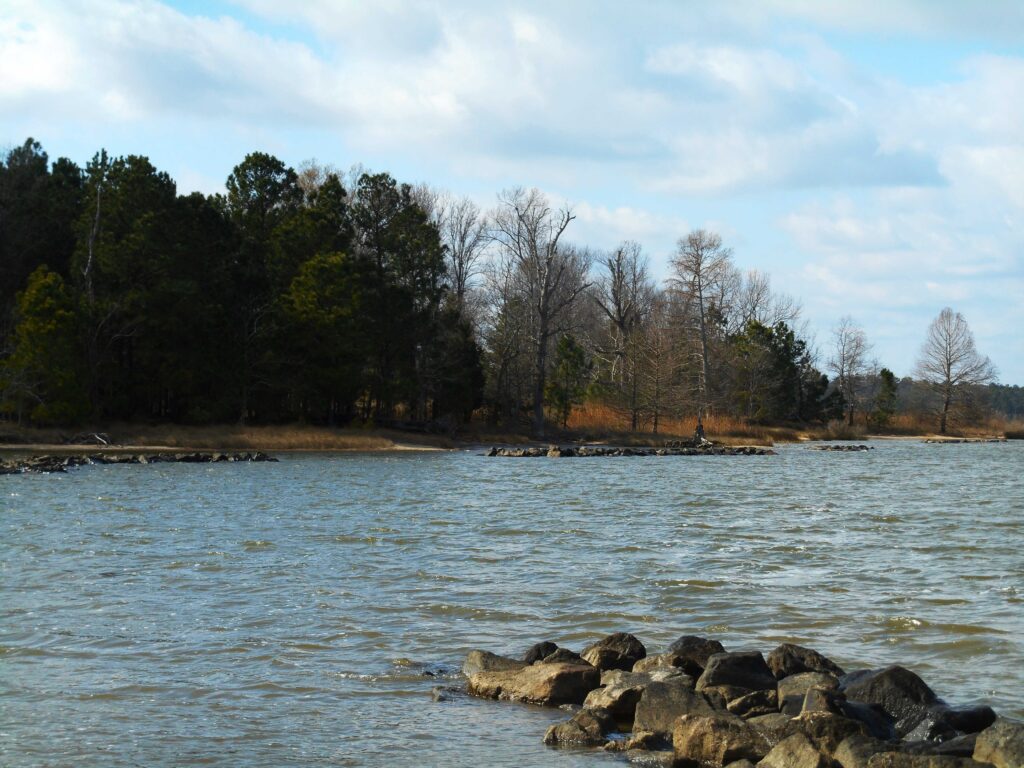
Black Point, at the tip of Jamestown Island, is slowly disappearing under the James River as water levels rise. Attempts to harden the shoreline with rip rap breakwaters only slows the process.
Structural Solutions
I once purchased a home in mid-August, during a dry spell, without first doing my homework to learn more about the past history of this trendy, relatively new neighborhood. I didn’t know until that winter that my part of the neighborhood was built on fill and clay and didn’t drain. There were inches of standing water in my back yard for weeks. That experience initiated a steep learning curve to figure out how to manage the water and drain the yard.
A system called ‘French drains’ helped solve the problem, along with some additional plantings. Creating the drains meant digging trenches where new paths would lie, lining them with pea gravel, and installing perforated plastic drainage pipes in the trenches. The pipe is covered with gravel. Water from the surrounding saturated soil drains into the gravel and then flows into the pipe. Of course, the pipes are set up so water drains into a rain garden, or culvert, or some area that can manage the run-off. We ended up building raised wooden walkways over the French drains. Plants growing along these French drains also help to absorb excess water and process it back into the atmosphere.
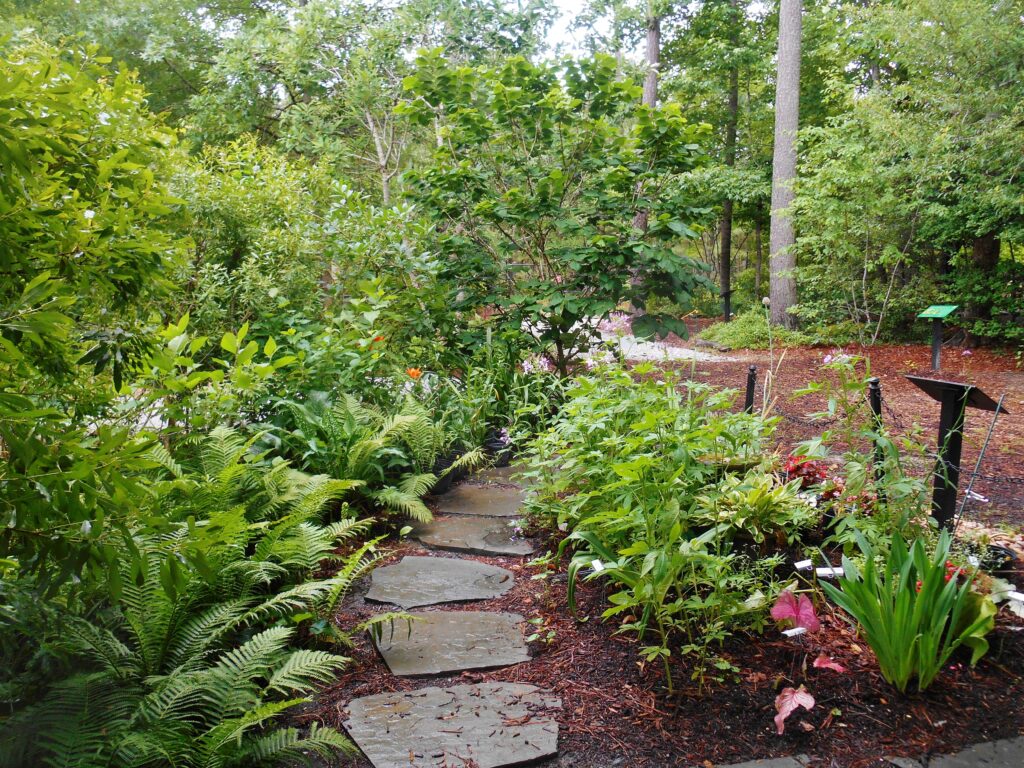
Permeable hardscape allows water to soak into the soil, while also providing solid surfaces for paths, patios, and driveways. The Williamsburg Botanical Garden Shade Garden in 2019.
Permeable paving systems for hard scape areas like driveways, patios and pathways allow water to soak into the soil, and slow run off during heavy rain. There are specialized products available, as well as ways to place more traditional materials like bricks and concrete blocks, with spaces between them, where water can soak into the soil.
Some homeowners install barrels or large tanks to capture rainfall from their gutters and other drainage systems, to use later for irrigation. This is an investment, and may not be practical everywhere. But rain and run-off are valuable resources. If we can find ways to keep them on our own land for future use, we will enjoy the benefits of free water to keep our gardens watered when rain is scarce.
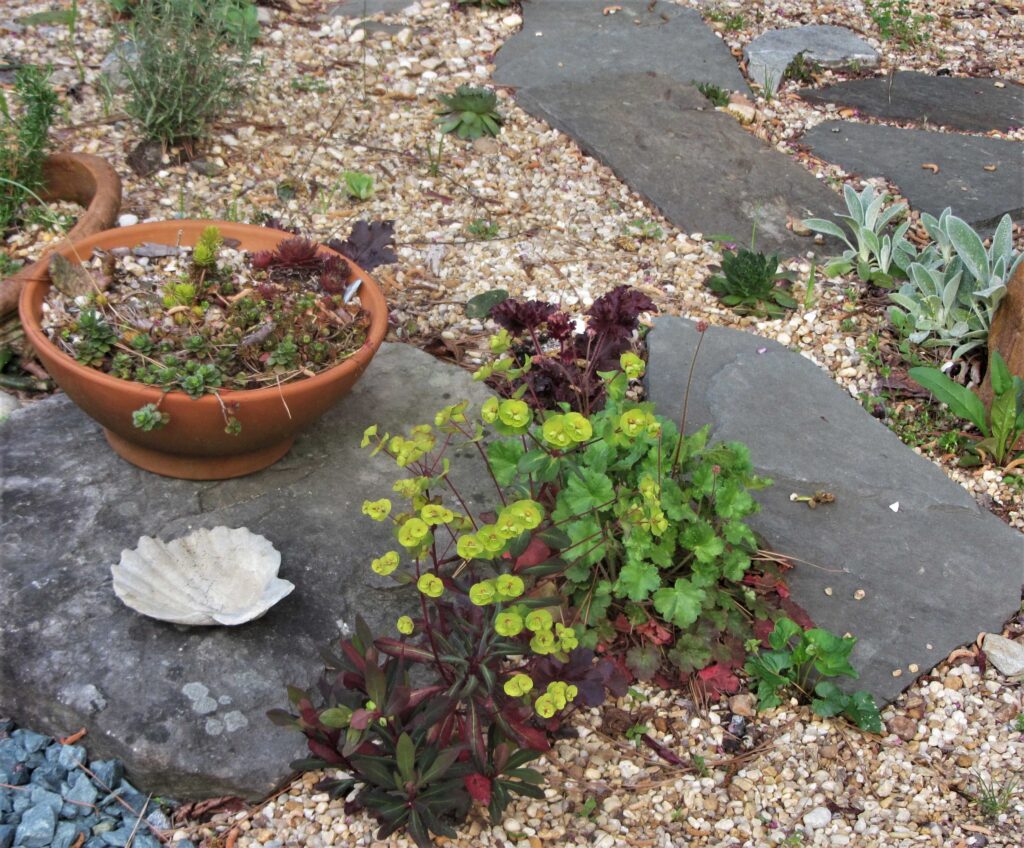
Succulent Euphorbia and Sedums, and velvet leaved Stachys byzantina, all have adaptations that allow them to survive drought. Rock and gravel help hold moisture in the soil when rain becomes scarce. The Succulent Garden at the Williamsburg Botanical Garden and Freedom Park Arboretum.
Managing Drought
But what happens when it doesn’t rain? When the soil grows drier with each passing day and plants grow thirsty? Some of us turn to irrigation, particularly to sustain new plantings. Soaker hoses or irrigation systems are the most efficient, where they are practical. Hand watering takes time but is the most flexible. Most localities have water use restrictions on sprinklers and other overhead watering systems, and much of that water runs off or evaporates.
Some plants naturally withstand periods of drought better than others. Plants with deep roots, small, fleshy leaves, waxy coatings on their leaves, and other adaptations originate in areas with hot sunny days and little rain. Plants like cactus and other succulents store up water in their stems and leaves, but too much water in the soil around their roots can kill them. Some plants seem to die off during drought, only to sprout new growth after a good rain. Some perennials can generate multiple flushes of new growth, as needed, during the season. There are many design tricks to make a planting more drought tolerant.

Evergreen hellebores have thick, waxy leaves to conserve moisture during dry spells. They bloom in winter and early spring. These grow with periwinkle, Vinca minor, a tough ground cover vine that is also drought tolerant, and daffodils. Each of these species was imported from Europe during colonization in our area.
A Virginia gardener succeeds with a mix of water-loving plants that can withstand periods of wet saturated soils, and drought tolerant plants that are tough enough to survive occasional drought. Plants that require sharp drainage can be planted on mounds and berms, or in containers. Many of these plants, particularly shrubby Mediterranean evergreen herbs such as rosemary and lavender, appreciate a gravel mulch. Water loving plants thrive in the low spots, or areas of clay, that can’t provide such dependable drainage. And the best choices are plants that can tolerate both wet soils and periods of drought. And there is a wide selection of those.
The Question of ‘Invasive’ Plants
Some of our most resilient, drought tolerant, and functional plants were classified as ‘invasive’ in recent years. Nearly every ‘invasive’ plant was imported to America from Europe, Asia, or Africa to solve a specific problem or meet a specific need. It wasn’t until mid-century that the federal government began an ‘invasive species’ list, and at that time it was mostly for insects, not plants. Those plants considered invasive generally interfered with agriculture. Each state now has its own list, though many of those plants remain available at area nurseries, rarely labeled as invasive. Good, functional landscape plants remain desirable to many gardeners despite the label ‘invasive.’
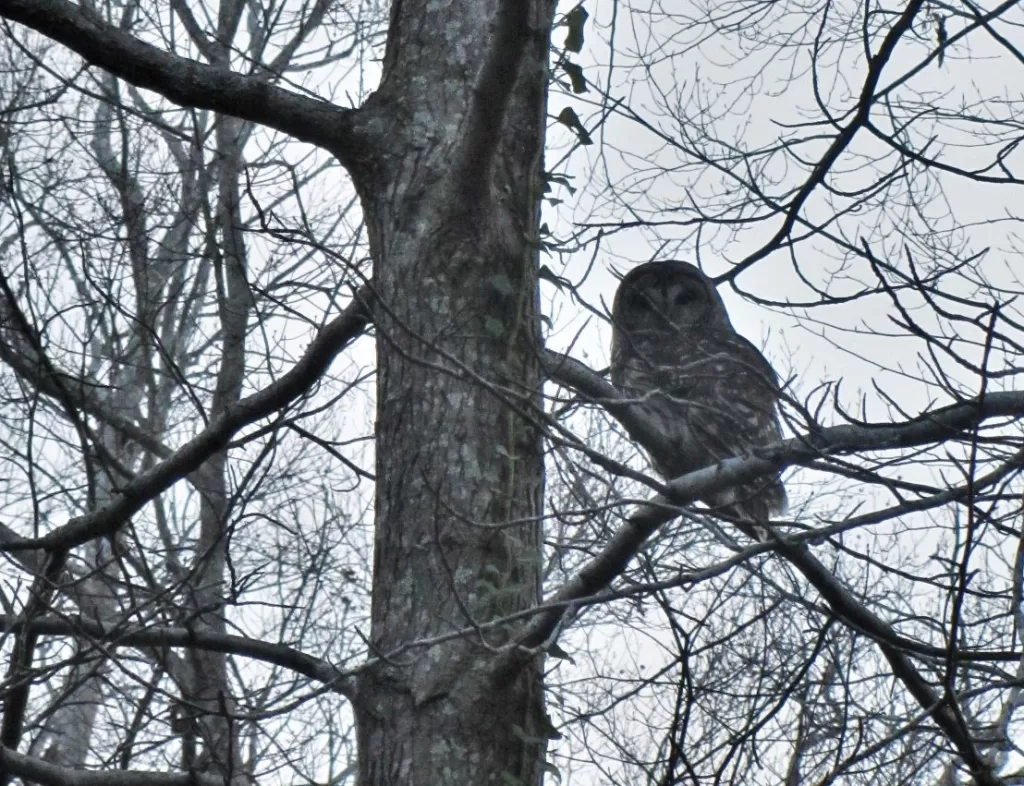
English ivy is an established ground cover vine in our area and often climbs trees. It is a functional plant in many ways, is an important element of the Colonial landscape, and is also on the invasive species list for our area.
Dr. Doug Tallamy’s 2009 book, Bringing Nature Home: How You Can Sustain Wildlife with Native Plants raised our awareness about the differences between native and imported plants. His original research that formed the basis of this book was carried out in a typical suburban yard where the landscaping consisted primarily of lawn and a few imported shrubs. His is an ecological perspective, from an entomologist’s point of view. After this book was published, many gardeners became more interested in planting native plants and repairing the web of life. This perspective encourages us to root out invasive, and sometimes even imported species, in favor of replacing them with local native plants. Doing this is intended to feed more insects, and thus support birds and other wildlife.
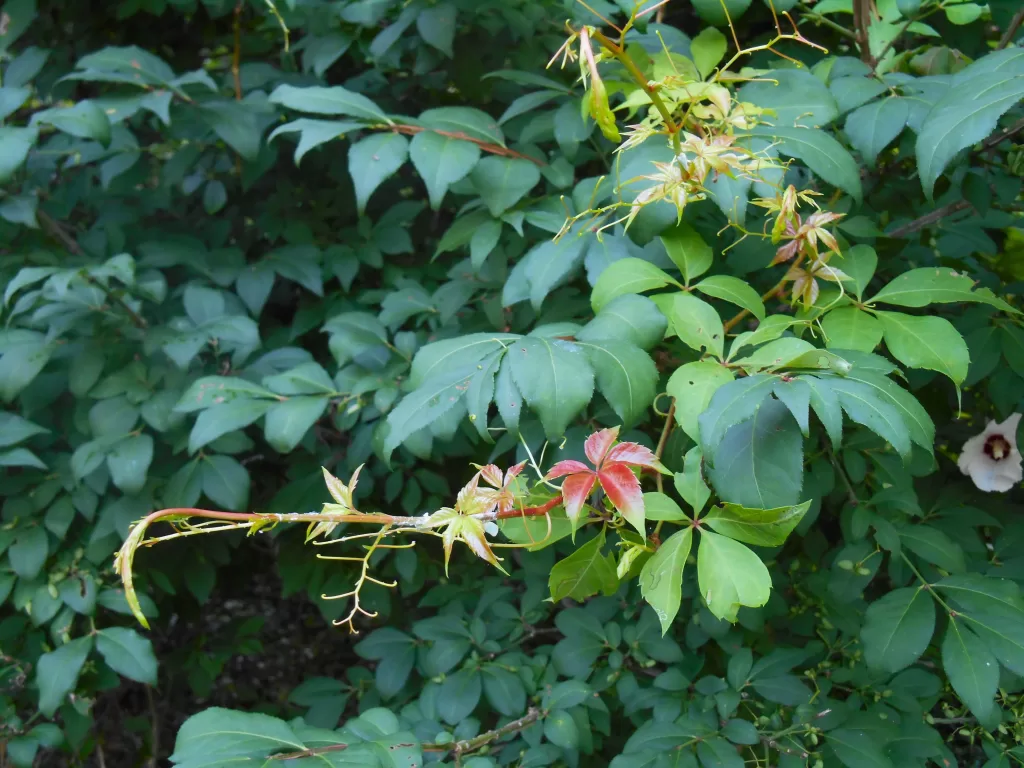
Virginia Creeper, Parthenocissus quinquefolia
Functional Vines for Ground Covers
Ivy, Hedera spp., was imported from its native territory in Europe for use as a ground cover in Colonial America. Evergreen, drought tolerant, and easy to grow, it holds and protects the soil against heavy rain, particularly on slopes. It becomes problematic when it grows up trees and walls, causing damage from its weight on branches and with its tiny aerial roots on walls. Ivy can absorb ‘occult rain’ like dew and humidity, and it requires almost no maintenance once it is established. Its insignificant flowers produce seeds, allowing birds to spread the plant beyond cultivation. This is one of several evergreen ground cover plants which tick all of the boxes for a resilient landscape that can manage stormwater efficiently.
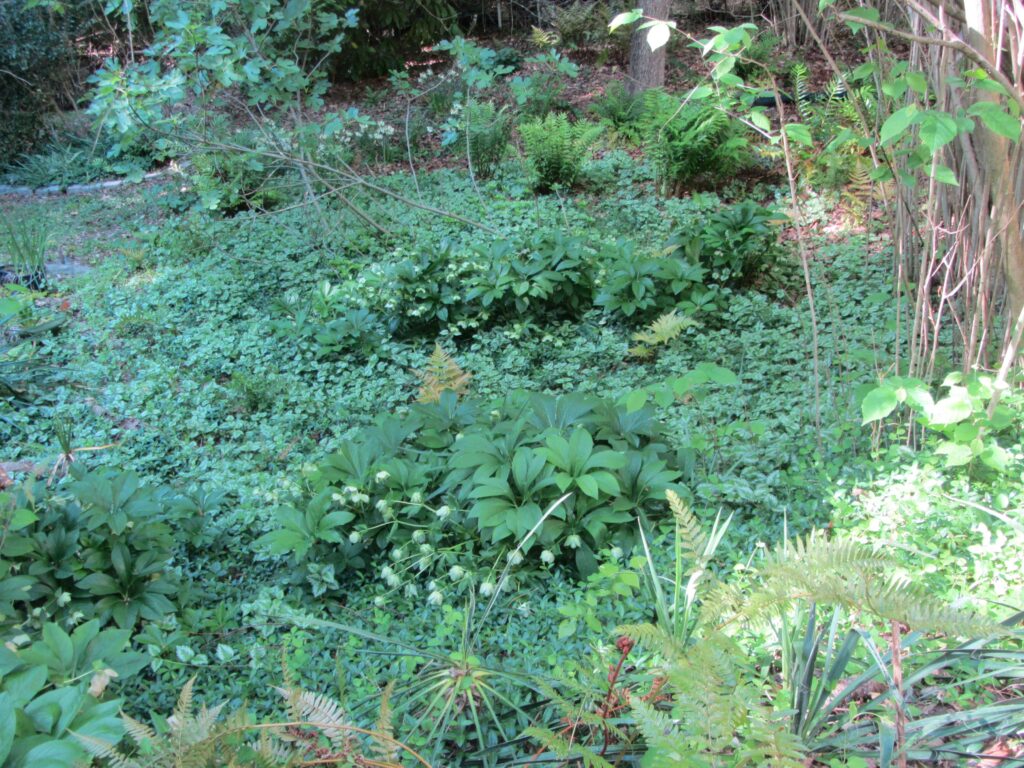
Periwinkle and dead nettle form a thick ground cover in this shady part of the garden. Hellebores, ferns, and Yucca add additional layers of vegetation and visual interest. This area is planted to control erosion, and is a work in progress as new plants are added seasonally. Spring, 2024.
Almost as popular as ivy, evergreen Vinca minor, or periwinkle, blooms in early spring, supporting early pollinators. Both ground cover vines can take root at each leaf note. A native, but deciduous, alternative is Virginia creeper, which turns scarlet in autumn and produces fruit for wildlife. It is related to grape vines and climbs aggressively. Another native alternative is Mitchella repens, partridgeberry. While partridgeberry produces flowers and fruits, it prefers moist, acidic soil in the shade and can be difficult to source. A very ornamental ground cover vine, with showy spring flowers silver marked leaves, is Lamium maculatum, or spotted dead nettle. A member of the mint family, it spreads quickly, is semi-evergreen, and very desirable for wildlife.

Camellia sasanqua and native oakleaf Hydrangea quercifolia provide abundant autumn color and hold their leaves through the winter. Drought tolerant, they can also tolerate wet soils and help manage stormwater run-off.
Taller Perennial Ground Covers
Taller perennials also serve well as ground covers whether massed or used as specimens among other ground covers. Carex spp. sedges, look like low, shaggy grasses. There are both native and imported species appropriate for many situations. Ophiopogon spp., mondo turf, lilyturf, Liriope, and the many selections of these plants are generally low maintenance, neat, and some bloom in early summer. They are tough, evergreen plants with extensive, persistent roots. Some, like black mondo grass, are frequently grazed by deer, however. Pachysandra spp. are another popular choice, particularly for shade. There are both native and imported selections. Allegheny spurge, native to our area, is semi-evergreen and has showy flowers in mid-spring.
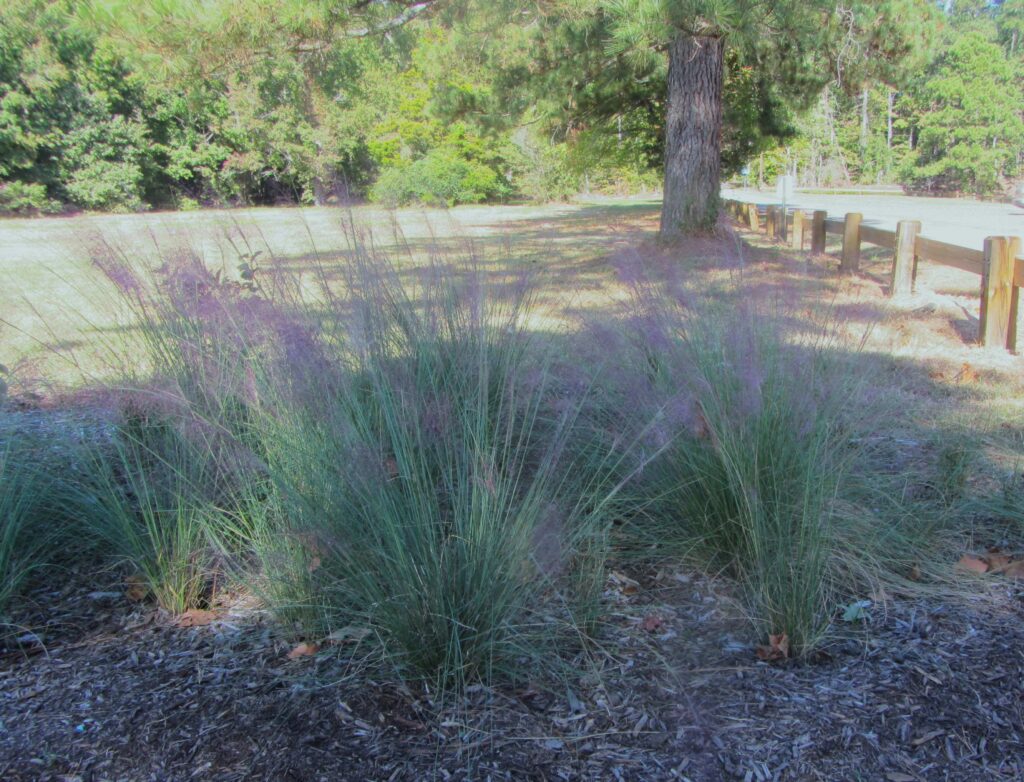
Pink muhly grass blooms in its first season growing in one of the new riparian buffer beds at the Brickyard Landing Park in James City County, October 2024.
Several native grasses, of varying heights and dimensions, grow as long season perennials that can be left standing until the following spring. They both slow and absorb run-off, as they grow into an excellent riparian buffer to filter run-off storm water before it enters creeks, rivers, and ponds. Most grasses grow best in full sun to part shade. One of the most beautiful is pink muhly grass, which can grow to 3′ tall, develops a dense mat of roots, and can grow on many different types of soil. Its seed heads are pink with a fine, airy texture. Other excellent grasses include little blue stem and broomsedge, Andropogon spp., which can grow 2′-4′ tall. Purple love grass, a warm season grass that grows to only 8″-14″ tall and a foot wide can be mowed a few times each year and can take some foot traffic. It thrives in hot, dry weather, is somewhat salt tolerant, and can take some foot traffic. It is a good matrix, or ‘filler,’ to use between larger plants.

Carex may look like grass, but is a very tough, evergreen perennial sedge. The WBG-FPA spring 2022.
Hellebores, native to Europe, bloom in winter, thrive in dry shade to part sun, and have large, waxy evergreen leaves. These versatile, tough perennials feed insects from showy flowers when little else blooms in winter and early spring. Some selections seed prolifically, leading some to consider them invasive. They grow into a thick mat of vegetation on many types of soil, needing very little care once established. Ajuga is another low, spreading, semi-evergreen perennial with showy foliage and spring flowers that grows well in difficult situations. It spreads by sending out new plantlets on reaching, horizontal stems that will root some distance away from the mother plant. These plantlets eventually form mats in moist soil, growing well below trees and in other shady areas where grass won’t thrive. Some localities consider this European perennial an invasive plant because it spreads so well.
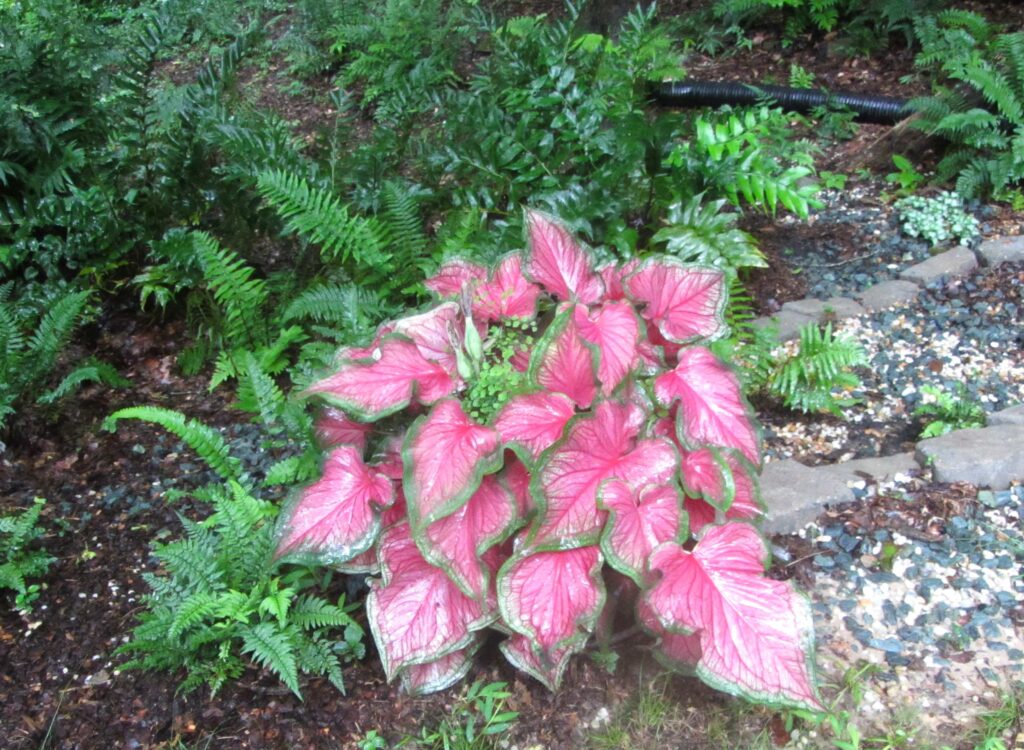
Hardy, evergreen ferns with thick waxy leaves prove surprisingly drought tolerant, once they are established. They are excellent at holding sloping ground against erosion.
Perennial Ferns for Ground Cover
Many ferns help manage water and prevent erosion, whether evergreen or deciduous. Three of the best are native Christmas fern, Polystichum acrostichoides, ‘Brilliance’ autumn fern, Dryopteris erythrosora, and Japanese holly ferns, Cyrtomium spp. An Asian Polystichum, Korean tassel fern, also performs well in deep shade. All of these have substantial, waxy, evergreen fronds bringing color and structure to the landscape year-round. These are excellent choices for foundation plantings. These ferns are relatively easy to source and are affordable. Some deciduous native ferns thrive in saturated soil and can be very helpful in dissipating standing water. Cinnamon ferns, ostrich ferns, royal ferns, marsh ferns, and sensitive ferns are very useful in damp areas.
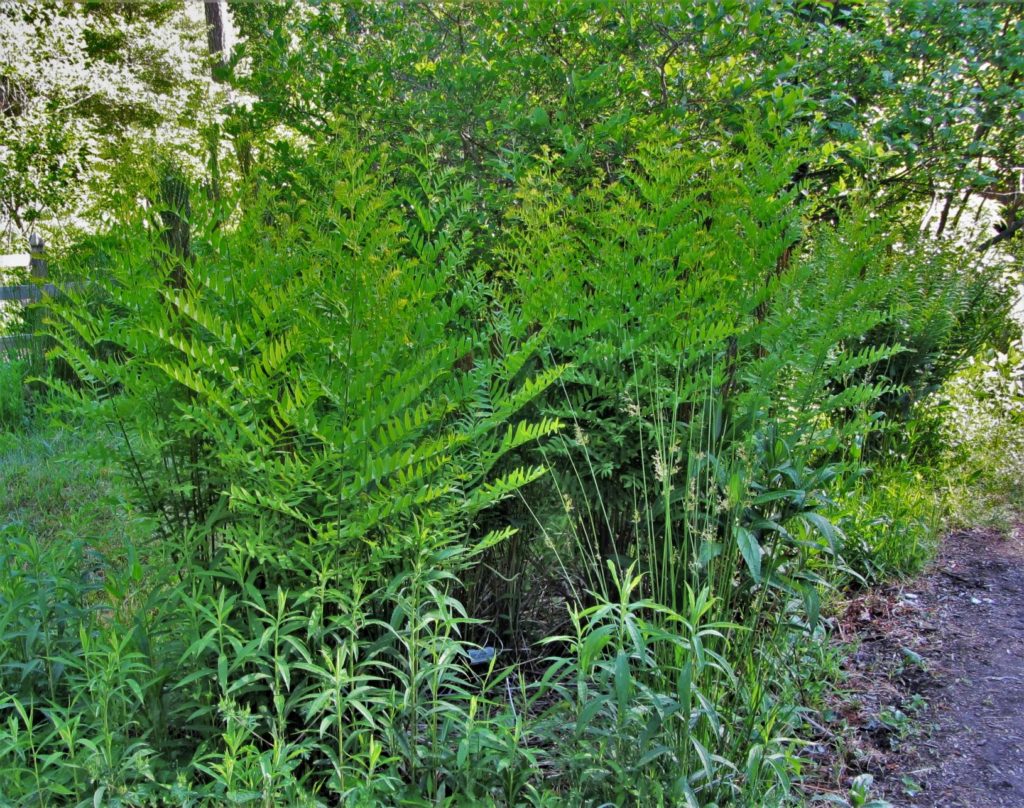
Royal fern grows in the edge of wetlands at the Williamsburg Botanical Garden. This is one of our tallest native ferns.
Even semi-evergreen or deciduous ferns and flowering perennials can protect the soil with their extensive roots, particularly when fading fronds are left in place to protect the soil until new growth emerges in the spring. It is wise to leave garden clean-up after frost as late into the season as possible, so faded plants protect the soil. Cut off spent leaves and stems at ground level, leaving even the roots of annuals in place, so they feed the soil.
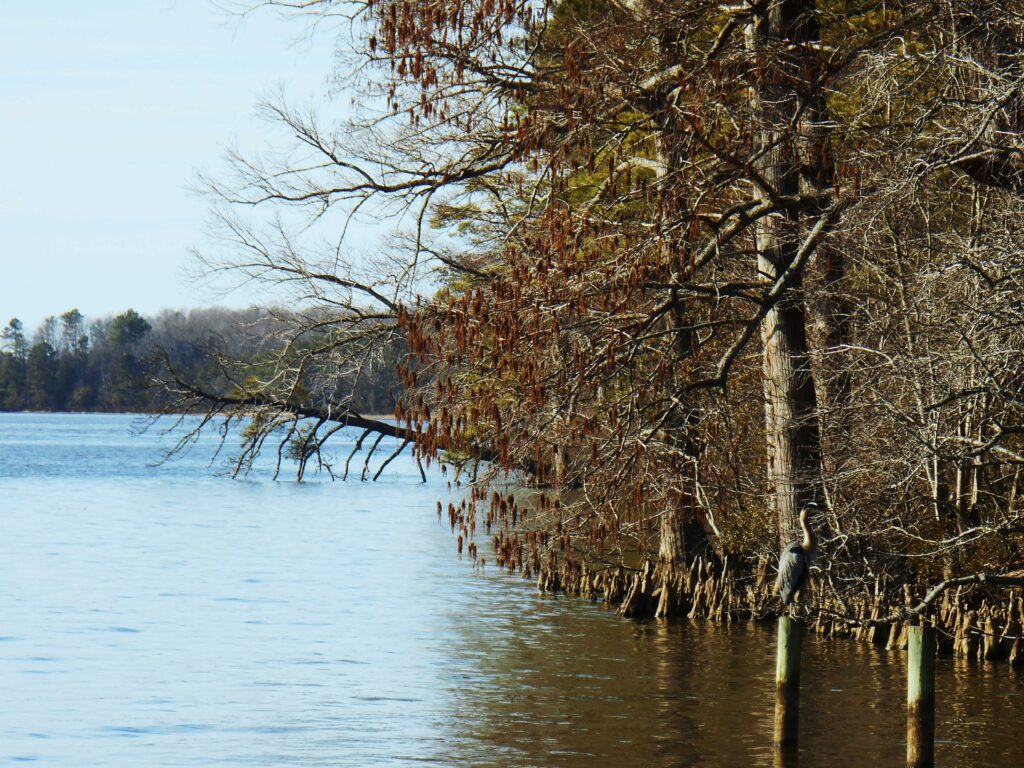
Bald cypress knobs, part of the trees’ root systems, also help harden and protect the river bank here along the Chickahominy River. Chickahominy Riverfront Park March 2015.
Trees and Shrubs to Manage Storm Water
A variety of shrubs and trees are appropriate choices to manage storm water and sequester carbon; enough to fill a book. Look for choices that have deep roots, even taproots, and that can thrive in a variety of conditions. Waterfront properties that experience occasional flooding with brackish or salty water need salt tolerant plants, like bald cypress, wax myrtle, saltbush or sea myrtle, and yaupon holly.
Remember the power of evergreens to scrub the air and process water even during the winter. When considering native trees, keep in mind that some species grow best in wet soils and others prefer drier, upland conditions. Trees planted in clusters, so their roots can intertwine, will be less likely to fall in strong winds than trees growing alone out of a lawn. In nature, plants grow together in groups. Our gardens will be most resilient when we take lessons from nature to guide our own plantings.

American holly grows along the Colonial Parkway near Jamestown. Drought tolerant, holly can also tolerate wet soil and a variety of light and soil conditions. Deer rarely touch it. Holly grows here alongside American beech trees and an oak.
Seeds of Solutions
Experience teaches us to look for the seeds of solutions within every challenge. The climate challenge is no different. Our planet’s ecosystem seeks balance, and finds way to compensate when patterns shift too far in one direction or another. The very fact that the elements that comprise the greenhouse gasses causing our planet to warm are those same elements plants need to grow should help us to understand the role plants can play in cleaning up our atmosphere and regulating its temperature. Plants that cooled our atmosphere eons ago, entombed under layers of the planet’s crust over time, eventually formed oil, coal and natural gas. We are releasing the carbon sequestered long, long ago back into the atmosphere now. We can use plants to recapture that carbon, and other elements released through combustion. Increased rainfall helps support that growth.
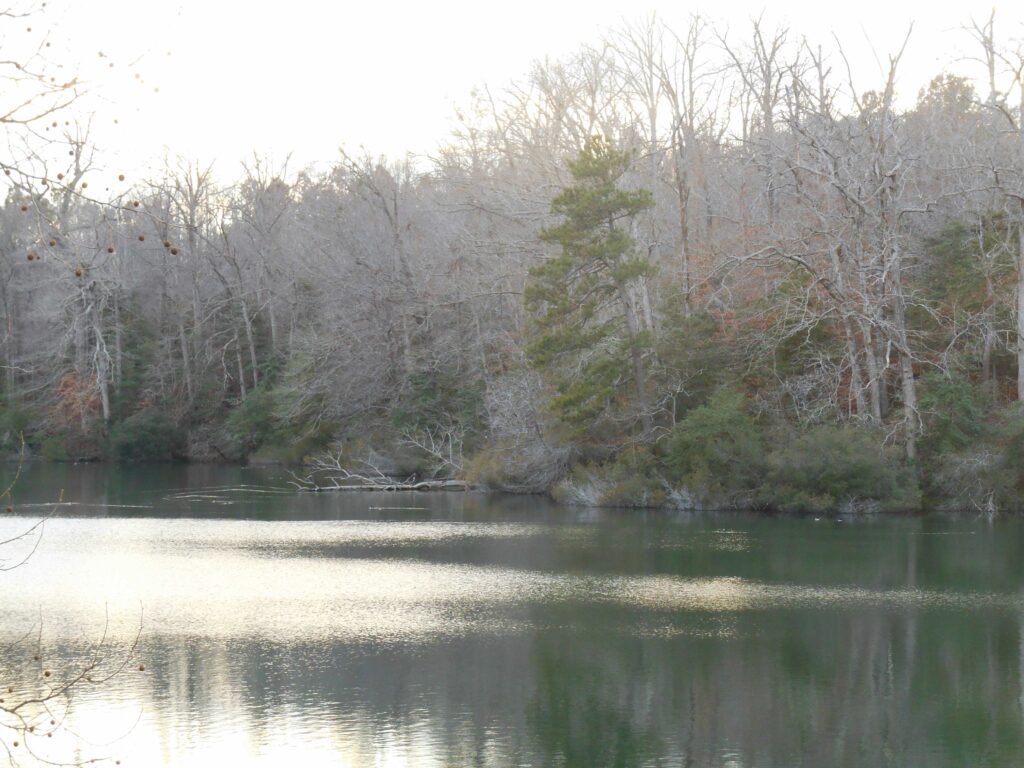
Evergreen plants continue cleaning the air and managing rainfall year round, as they add color and structure to the winter landscape. Scotts Mill Pond in York County, January 2017.
Left to her own ways, Earth, Gaia, would heal herself. But human intervention has led to cutting trees, paving and developing land that once supported forests and prairies, and thus changing weather patterns. Industrial agriculture has changed the soils so they require manufactured fertilizers to support crops. Irrigation can deposit salts and other chemicals on farmlands. We often do what we believe benefits us without understanding how those actions affect larger systems. And we don’t always understand what causes wildcard events like wildfires, hurricanes and floods, or how they change the balance going forward.
This leaves us to do what we can, where we are, with whatever resources we have to heal and restore the land we call home. Maybe we send a few dollars to a NGO planting trees on wildfire scars. Maybe we contribute to saving a rain forest. But the actions that really matter are those we take at home. And the actions we take to improve our own environment, and protect our own home, can also help bring new life and resilience to the larger ecosystem. If enough of us join the effort, we can make a measurable, positive impact, to address our shared challenges.
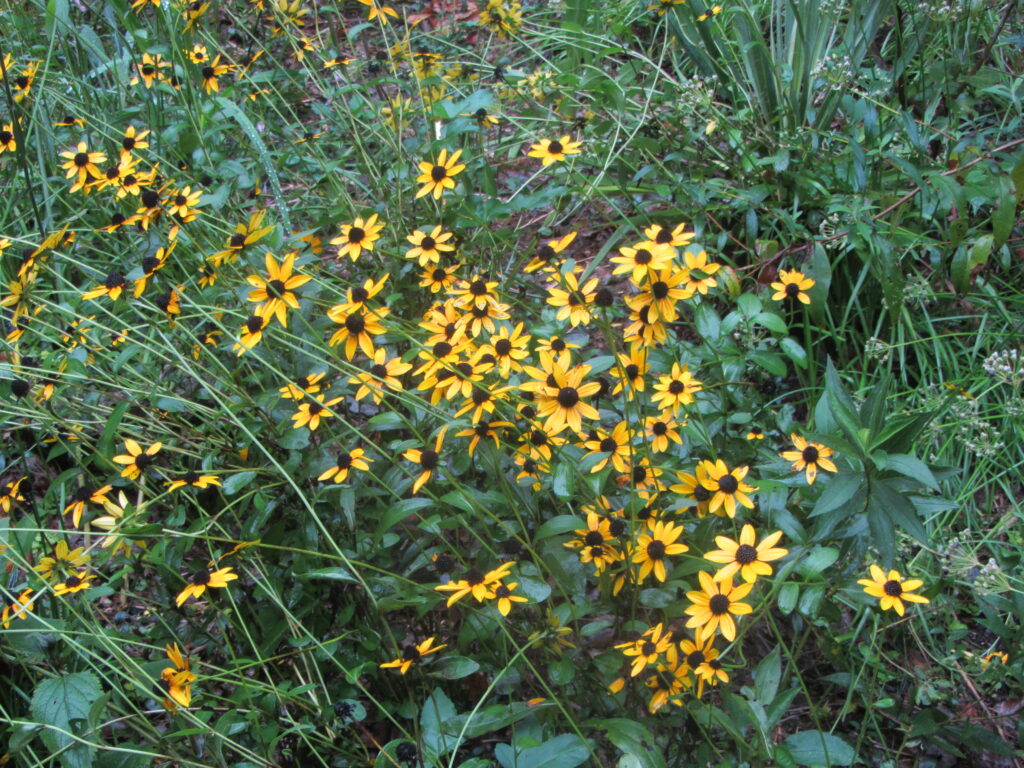
Black-eyed Susans, Rudbeckia hirta
All photos by E. L. McCoy
Find More Information in These Resources:
Learn more about 55 native trees and shrubs indigenous to our area.
Native Plants for Southeast Virginia A guide which showcases many attractive varieties of plants native to Southeast Virginia, which includes the Hampton Roads region. It includes information about how each plant supports wildlife.
Which Tree Should I Plant? A guide was produced by the Upper and Middle James Riparian Consortium to educate Virginians about the woody native plants of our riparian areas.
The North Carolina Extension Gardener Toolbox
Protecting our Waterways and Wetlands: James City County’s Stormwater and Resource Protection Division
Bibliography
Dirr, Michael A. Dirr’s Encyclopedia of Trees and Shrubs. 2016.
Lambe, Dan. Now Is the Time for Trees: Make an Impact by Planting the Earth’s Most Valuable Resource. 2022.
Lewis, Hannah and Paul Hawken. The Mini-Forest Revolution: Using the Miyawaki Method to Rapidly Rewild the World. Chelsea Green Publishing. 2022.
Pearce, Fred. A Trillion Trees: Restoring Our Forests by Trusting in Nature. Greystone Books. 2022.
Phillips, Michael. Mycorrhizal Planet: How Symbiotic Fungi Work with Roots to Support Plant Health and Build Soil Fertility. Chelsea Green Publishing. 2017.
Silver, Akiva and Samuel Thayer. Trees of Power, Ten Essential Arboreal Allies. Chelsea Green Publishing. 2019.
Stamets, Paul. Mycelium Running: How Mushrooms Can Help Save the World. Ten Speed Press. 2005
Stewart, Amy. The Tree Collectors: Tales of Arboreal Obsession. Random House. 2024.
Shrubsole, Gary. The Lost Rainforests of Britain. William Collins. 2022.
Tallamy, Douglas. Bringing Nature Home: How Native Plants Sustain Wildlife in Our Gardens. 2007.
Tree, Isabella. Wilding: Returning Nature to Our Farm. New York Review Books. 2019.
Tree, Isabella. The Book of Wilding: A Practical Guide to Rewilding Big and Small. Bloomsbury Publishing. 2023.







